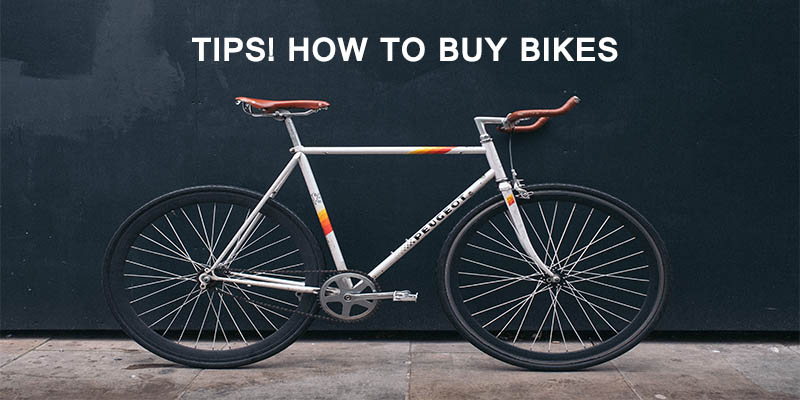Your Comprehensive Guide To Buying Bikes: Expert Tips And Considerations

Daisy
Last Updated: Oct 19, 2023

Consider this: You're about to embark on a journey, a quest to find the perfect bike that's not just a mode of transportation, but an extension of your personality and lifestyle. As your virtual bike expert, I'm here to help you navigate through the myriad of choices and considerations, ensuring you make an informed decision that you'll be happy with for years to come.
Buying a bike is much more than just a transaction. It's about understanding the nuances of fit and comfort, recognizing the significance of quality and durability, and appreciating the value of performance and functionality. In this guide, we'll delve deep into these aspects, dissecting them so you can understand what truly matters when making your choice.
But we won't stop there. We'll also explore 20 unique factors, each with its own weightage in the bike-buying process. These factors, ordered by their importance, will provide you with a comprehensive view of what to look out for, ensuring you leave no stone unturned. Whether you're a seasoned cyclist or a novice looking to venture into the world of biking, this guide promises to be an enlightening resource. So, let's gear up and pedal into the world of bikes together.
Our Tips
1. Understanding Your Riding Needs
Before you set foot in a bike shop or start browsing online, take a moment to understand your riding needs. Are you planning to use the bike for commuting? Weekend rides? Off-road adventures? The type of riding you plan to do will significantly influence the kind of bike you should buy.
2. Setting a Budget
Bikes come in a wide range of prices, and it's easy to get carried away. Before you start shopping, set a budget that fits your financial situation. Remember, you'll also need to factor in the cost of essential accessories and regular maintenance.
3. Key Features to Consider
When choosing a bike, pay close attention to:
- Frame Material: The material can affect the weight, strength, and comfort of the bike. Common materials include steel, aluminum, and carbon fiber.
- Component Quality: This includes gears, brakes, and suspension systems. Higher quality components often mean a smoother ride and longer lifespan.
- Size: A bike that fits you well will be more comfortable and easier to handle.
4. The Importance of Test Rides
Never buy a bike without taking it for a test ride first. This will give you a feel for the bike's handling and comfort. If a bike doesn't feel right during a test ride, it's probably not the right bike for you.
5. New Vs. Used Bikes: What to Consider
New bikes come with warranties and the assurance of pristine condition, but they can be pricey. Used bikes are often much cheaper, but they might need more maintenance and repairs. Consider your budget, mechanical skills, and patience when deciding between new and used.
6. Buying Bikes Online: Risks and Rewards
Online shopping offers convenience and often lower prices, but it also comes with risks. You can't test ride a bike online, and there's a chance the bike you receive won't be as described. If you decide to buy online, do so from a reputable seller and be sure to ask for detailed photos and descriptions.
7. Regular Bike Maintenance: A Must-Have Habit
Regular maintenance will keep your bike in good working order and extend its lifespan. This includes cleaning the bike, lubricating the chain, and checking the tires, brakes, and gears. If you're not comfortable doing this yourself, many bike shops offer maintenance services.
8. Essential Bike Accessories
Don't forget to budget for essential accessories. This includes a helmet, lights for night riding, a lock for security, and a pump for tire maintenance. These accessories will keep you safe and make your riding experience more enjoyable.
Factors to Consider When Buying a Bike
Budget: The first thing you need to consider when buying a bike is your budget. Bikes can range in price from a few hundred to several thousand dollars. Your budget will dictate the type of bike you can afford and its features. It's important to set a budget before you start shopping to avoid overspending.
Type of Riding: Different types of bikes are designed for different types of riding. Road bikes are ideal for paved surfaces, mountain bikes are designed for off-road use, and hybrid bikes can handle a variety of terrains. Consider where and how you plan to use your bike to help determine the type of bike you need.
Frame Material: The bike's frame material can affect its weight, strength, and ride quality. Common materials include aluminum, steel, carbon fiber, and titanium. Each material has its pros and cons, so consider your riding needs and preferences when choosing.

Component Quality: The quality of the bike's components, such as the gears, brakes, and suspension, can significantly affect its performance and longevity. Higher-quality components often result in a smoother ride and require less maintenance.
Fit and Geometry: The fit of the bike and its geometry (the shape and design of the frame) are critical for comfort and efficiency. Factors like the bike's size, the height and position of the handlebars, and the position of the seat can all affect how comfortable you are on the bike.
Suspension System: The suspension system is particularly important for mountain bikes, as it helps absorb shock from rough terrain. However, even if you're not planning to ride off-road, a good suspension system can make your ride more comfortable.

Wheel Size: The size of the bike's wheels can affect its speed, maneuverability, and how well it handles certain terrains. Smaller wheels are typically more maneuverable, while larger wheels can roll over obstacles more easily.
Gearing System: The bike's gearing system can affect its speed and how easy it is to ride on different terrains. Bikes with more gears offer more versatility but can be more complex to use.
Braking System: There are several types of bike brakes, including rim brakes, disc brakes, and coaster brakes. Each type has its pros and cons, so consider your riding conditions and personal preferences when choosing.
Availability of Spare Parts: Finally, consider the availability of spare parts for the bike you're considering. If parts are difficult to find or expensive, it could make maintenance and repairs more challenging in the future.
FAQS
1. How to Choose the Right Type and Size of Bike?
Choosing the right type and size of bike depends on your intended use and body measurements. For example, road bikes are suitable for paved surfaces while mountain bikes are designed for off-road trails. Hybrid bikes are versatile and can handle both. The size should match your height and inseam length for a comfortable ride. Bike manufacturers often provide size charts to help you choose the right fit.
2. What are the Budget Considerations?
Your budget will determine the quality and features of the bike you can afford. Higher-end bikes usually have lighter frames, better components, and superior performance but come at a higher cost. However, mid-range bikes can also offer good value for money. Consider the costs of maintenance and necessary accessories in your budget.
3. What are the Key Features to Look for?
Key features to look for include the bike's frame material, wheel size, gear system, brakes, and saddle comfort. The frame should be sturdy and lightweight, gears should shift smoothly, brakes should provide effective stopping power, and the saddle should be comfortable for long rides.
4. How to Test Ride a Bike?
Test riding a bike gives you a feel of its performance and comfort. Check the bike's fit, try the gears and brakes, and see how it handles different terrains. Some bike shops allow test rides before purchase.
5. What are the Advantages of Buying a Used Bike?
Buying a used bike can save you money and is also eco-friendly. You can often find high-quality bikes that are barely used at a fraction of the cost of new ones. However, it's important to thoroughly inspect the bike for any signs of damage or excessive wear.
6. How to Determine if a Used Bike is a Good Investment?
Check the bike's condition, age, brand, and model. Look for signs of rust, cracks, or excessive wear on the frame, tires, and components. Ask about the bike's history and maintenance. Compare the asking price with the original price and current market value. A bike mechanic can also help inspect the bike.
7. What are Some Tips on Bike Maintenance?
Regular maintenance extends the lifespan of your bike and ensures a smooth ride. This includes cleaning the bike, lubricating the chain, checking the tire pressure, adjusting the brakes and gears, and getting a professional service annually.
8. What are the Necessary Accessories?
Necessary accessories include a helmet for safety, lights and reflectors for visibility, a lock for security, a water bottle and holder for hydration, and a repair kit for emergencies. Fenders and a rack can be useful for commuting.
9. What are the Risks of Buying a Bike Online?
Buying a bike online can be risky as you can't physically inspect or test ride the bike. There's also the risk of scams, incorrect product descriptions, or shipping damage. However, reputable online retailers offer customer protection, detailed product information, and user reviews to mitigate these risks.
10. How to Make Informed Decisions When Buying a Bike?
Research different types and brands of bikes, read reviews, compare prices, and consider your needs and budget. Test ride different bikes if possible. Consult with bike experts or experienced cyclists for advice. Making informed decisions will help you choose a bike that best suits your needs and provides value for money.
Final
In conclusion, the discussion provided a comprehensive guide to buying a bike, addressing various aspects from choosing the right type and size to considering budget and key features. The importance of test rides, regular maintenance, and necessary accessories were also highlighted. The discourse offered valuable insights into the pros and cons of buying used bikes and online purchases, suggesting strategies to mitigate potential risks. Ultimately, the conversation underscored the necessity of making informed decisions based on thorough research, expert advice, and personal needs when purchasing a bike.

